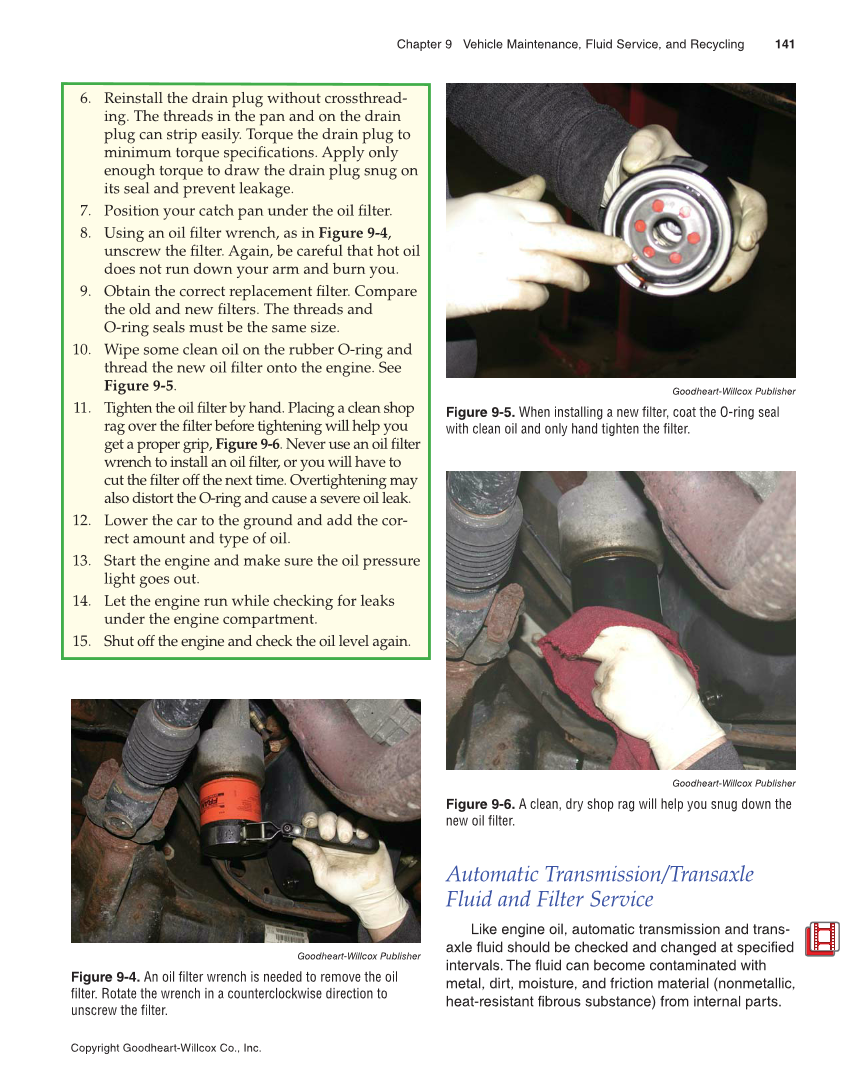140 Section 1 Introduction to Automotive Technology Copyright Goodheart-Willcox Co., Inc. Never add too much oil to an engine. Pour in only enough oil to reach the FULL mark. Overfilling can cause oil foaming (the oil absorbs air bubbles), which reduces the oil’s lubricating ability. Warning Be careful when checking or chang- ing vehicle fluids. At operating temperature, oil and other fluids can be hot enough to burn your hand, arm, and face. Wear a face shield and oil-resistant gloves when changing an engine’s oil and filter. Adding Engine Oil Before adding engine oil, obtain the right kind of oil (weight, detergent, synthetic). Unless you have a very high mileage engine, use the same weight of oil that was installed during the last oil change. Use heavier or thicker oil in engines with very high mileage, especially if the engine is knocking, smoking, or has low oil pres- sure. Thicker oil will help raise oil pressure, cushion excessive bearing clearance, reduce light knocking, and help lower engine blow-by and smoking slightly. For example, some engines require zero weight oil when new. When these engines reach 200,000 miles, they will normally benefit from heavier oil. To add oil to the engine, remove the oil cap, which is usually on the valve cover. Install a small, clean fun- nel into the engine opening. Without spilling, pour the oil slowly into the funnel and engine. Changing Engine Oil and Filter When changing engine oil, make sure the engine is warm and the vehicle is sitting level. This will ensure that more of the oil contaminants are suspended in the oil and are drained out of the engine. If the oil is cold, the oil will drain more slowly and debris will settle to the bottom of the oil pan and cylinder heads. Service Procedure To change the engine oil: 1. Warm the engine to operating temperature. 2. Put on eye or face protection and work gloves. 3. Raise the vehicle on a lift or place it on jack stands in a level position. 4. Place a catch pan under the oil drain plug. 5. Unscrew the drain plug by turning it coun- terclockwise. Be careful, as the oil is hot. Allow enough time for the oil to drain com- pletely and stop dripping out of the pan. See Figure 9-3. A—Warm engine to full operating termperature. Then unscrew oil drain plug in counterclockwise direction. B—Be careful not to let hot oil burn your hand or arm. Allow all old oil to drain into catch pan for several minutes. Goodheart-Willcox Publisher Figure 9-3. Note the basic steps for draining old oil from an engine.
Modern Automotive Technology, 9th Edition Page 140 (178 of 1888)
Powered by Tizra® |
Extracted Text (may have errors)
140 Section 1 Introduction to Automotive Technology Copyright Goodheart-Willcox Co., Inc. Never add too much oil to an engine. Pour in only enough oil to reach the FULL mark. Overfilling can cause oil foaming (the oil absorbs air bubbles), which reduces the oil’s lubricating ability. Warning Be careful when checking or chang- ing vehicle fluids. At operating temperature, oil and other fluids can be hot enough to burn your hand, arm, and face. Wear a face shield and oil-resistant gloves when changing an engine’s oil and filter. Adding Engine Oil Before adding engine oil, obtain the right kind of oil (weight, detergent, synthetic). Unless you have a very high mileage engine, use the same weight of oil that was installed during the last oil change. Use heavier or thicker oil in engines with very high mileage, especially if the engine is knocking, smoking, or has low oil pres- sure. Thicker oil will help raise oil pressure, cushion excessive bearing clearance, reduce light knocking, and help lower engine blow-by and smoking slightly. For example, some engines require zero weight oil when new. When these engines reach 200,000 miles, they will normally benefit from heavier oil. To add oil to the engine, remove the oil cap, which is usually on the valve cover. Install a small, clean fun- nel into the engine opening. Without spilling, pour the oil slowly into the funnel and engine. Changing Engine Oil and Filter When changing engine oil, make sure the engine is warm and the vehicle is sitting level. This will ensure that more of the oil contaminants are suspended in the oil and are drained out of the engine. If the oil is cold, the oil will drain more slowly and debris will settle to the bottom of the oil pan and cylinder heads. Service Procedure To change the engine oil: 1. Warm the engine to operating temperature. 2. Put on eye or face protection and work gloves. 3. Raise the vehicle on a lift or place it on jack stands in a level position. 4. Place a catch pan under the oil drain plug. 5. Unscrew the drain plug by turning it coun- terclockwise. Be careful, as the oil is hot. Allow enough time for the oil to drain com- pletely and stop dripping out of the pan. See Figure 9-3. A—Warm engine to full operating termperature. Then unscrew oil drain plug in counterclockwise direction. B—Be careful not to let hot oil burn your hand or arm. Allow all old oil to drain into catch pan for several minutes. Goodheart-Willcox Publisher Figure 9-3. Note the basic steps for draining old oil from an engine.


